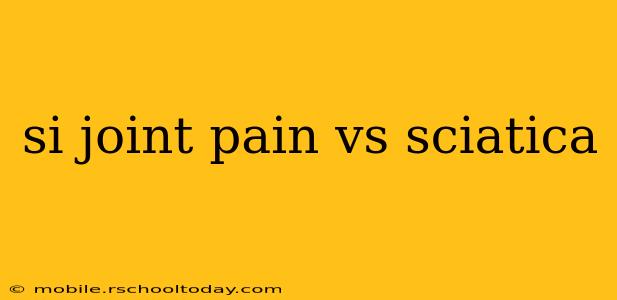Sciatica and sacroiliac (SI) joint pain are both common sources of lower back and leg pain, often causing confusion due to their overlapping symptoms. However, understanding the key differences is crucial for accurate diagnosis and effective treatment. This article will delve into the nuances of each condition, helping you differentiate between them and navigate your path to relief.
What is SI Joint Pain?
The sacroiliac joints are located where the sacrum (the triangular bone at the base of the spine) meets the ilium (the largest bone in the pelvis). These joints are crucial for weight-bearing and transferring forces between the upper body and legs. SI joint pain is characterized by pain in the lower back, buttocks, and sometimes the groin or upper thigh. The pain is often described as a deep ache or sharp stabbing sensation, which can be aggravated by activities like standing, walking, or sitting for prolonged periods. It can also be triggered by twisting movements or changes in posture.
What is Sciatica?
Sciatica refers to pain that radiates down the leg along the sciatic nerve, the longest and widest nerve in the body. The sciatic nerve originates in the lower back and branches down through the buttocks and into the legs. Sciatica is typically caused by compression or irritation of the sciatic nerve, often due to a herniated disc, spinal stenosis (narrowing of the spinal canal), or spondylolisthesis (forward slippage of a vertebra). Sciatica pain can range from mild discomfort to severe, debilitating pain, and is often accompanied by numbness, tingling, or weakness in the affected leg.
What are the Key Differences Between SI Joint Pain and Sciatica?
While both conditions can cause lower back and leg pain, several key differences help distinguish them:
Location of Pain:
- SI Joint Pain: Primarily localized in the lower back, buttocks, and sometimes the groin or upper thigh. The pain rarely extends below the knee.
- Sciatica: Radiates down the leg, often following the path of the sciatic nerve. The pain can extend all the way down to the foot, and often involves numbness, tingling, or weakness.
Type of Pain:
- SI Joint Pain: Often described as a deep ache, sharp stabbing pain, or a dull, constant throb. The pain may be worse with prolonged sitting, standing, or certain movements.
- Sciatica: Can range from a mild ache to a severe, burning, or shooting pain. It may be accompanied by numbness, tingling, or muscle weakness in the affected leg.
Aggravating Factors:
- SI Joint Pain: Aggravated by prolonged sitting, standing, walking, twisting movements, and changes in posture.
- Sciatica: Aggravated by certain movements like bending, lifting, coughing, or sneezing.
Physical Examination:
A physical examination can help differentiate between SI joint pain and sciatica. Specific tests can assess the range of motion in the SI joints and the presence of nerve root compression.
How are SI Joint Pain and Sciatica Diagnosed?
Diagnosing both conditions involves a combination of a thorough medical history, physical examination, and imaging studies such as X-rays, MRI, or CT scans.
How are SI Joint Pain and Sciatica Treated?
Treatment options for both conditions vary depending on the severity of symptoms and the underlying cause. Common treatments include:
- Conservative Management: This often includes rest, ice/heat therapy, over-the-counter pain relievers (like ibuprofen or acetaminophen), physical therapy, and exercise.
- Injections: Cortisone injections can be used to reduce inflammation in both SI joint pain and sciatica.
- Surgery: Surgery is generally reserved for severe cases that don't respond to conservative treatment. For sciatica, this might involve surgery to correct a herniated disc or spinal stenosis. For SI joint pain, surgery may involve fusion or other stabilization procedures.
Can You Have Both SI Joint Pain and Sciatica?
Yes, it's possible to experience both SI joint pain and sciatica simultaneously. For instance, SI joint dysfunction can sometimes lead to nerve irritation, contributing to sciatica. Accurate diagnosis is crucial to determine the best course of treatment addressing both conditions.
What are the Long-Term Outlook and Prevention Strategies?
The long-term outlook for both SI joint pain and sciatica varies depending on the severity and underlying cause. Many individuals find relief through conservative treatments. Prevention strategies often involve maintaining good posture, engaging in regular exercise (especially core strengthening exercises), and maintaining a healthy weight. Prompt medical attention is key for optimal outcomes.
This information is for general knowledge and does not constitute medical advice. Always consult with a healthcare professional for diagnosis and treatment of any medical condition.
